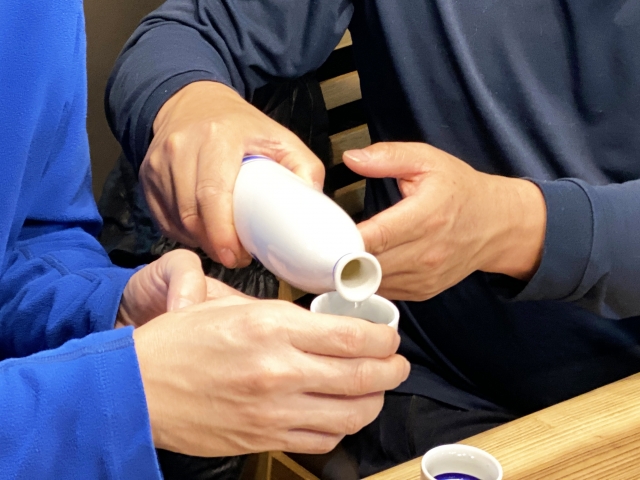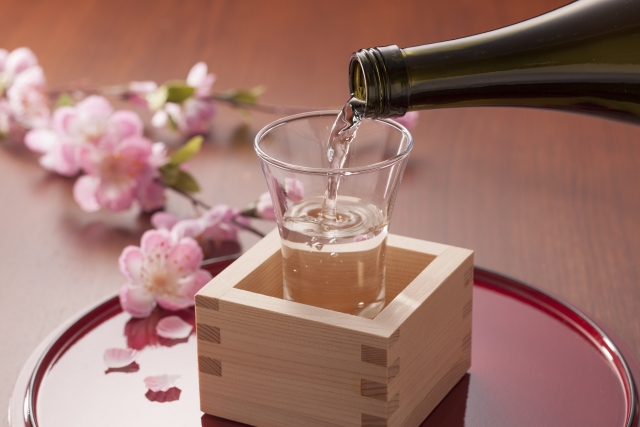Whether it’s pairing with delicious Japanese cuisine, visiting a traditional brewery, or simply understanding the deep cultural roots of this beverage, your journey into the world of sake promises to be an enlightening and enjoyable experience.
Kampai!
What is Sake?
Sake, pronounced ‘sah-keh‘, is a traditional Japanese alcoholic beverage made from fermented rice.
Known as Nihon-shu in Japan, it is often referred to as ‘rice wine‘ in the Western world.
However, its production process is closer to beer, where starch is converted into sugars before being fermented into alcohol.
Fascinating Facts About Sake
- Sacred Significance: Sake is often used in Shinto rituals and ceremonies, symbolizing purification.
- Seasonality: While sake can be enjoyed year-round, traditionally it is seen as a winter drink.
- Serving Temperature: Depending on the type of sake and personal preference, it can be served either chilled, at room temperature, or warmed.
Types of Sake and Their Names
| English Name | Japanese Name | Pronunciation | Description |
|---|---|---|---|
| Junmai | 純米酒 | ‘Joon-mai’ | Pure rice sake with no additional alcohol. Rich and full-bodied. |
| Honjozo | 本醸造 | ‘Hon-joe-zo’ | Sake with a small amount of distilled alcohol. Light and easy to drink. |
| Ginjo | 吟醸酒 | ‘Gin-joe’ | Premium sake made with rice milled to at least 60% of its original size. Fragrant and complex. |
| Daiginjo | 大吟醸酒 | ‘Dai-gin-joe’ | Super-premium sake made with rice milled to at least 50% of its original size. Very fragrant and complex. |
Difference Between Sake and Other Alcoholic Beverages
Compared to wine or beer, sake has a unique flavor profile. It has a higher alcohol content than wine and beer, usually around 15-20%.
However, it doesn’t have the bitterness of beer or the acidity of wine, making it a smooth drink.
Sake Production Process
The production of sake involves the following steps:
- Polishing: The rice used for sake production is polished to remove the bran.
- Washing and Soaking: The polished rice is then washed and soaked.
- Steaming: After soaking, the rice is steamed.
- Koji Making: Some of the steamed rice is used to make Koji, rice cultivated with a specific mold.
- Fermentation: The Koji, remaining steamed rice, and water are mixed and allowed to ferment.
- Pressing, Filtering, and Pasteurization: After fermentation, the mixture is pressed, filtered, and pasteurized to produce the final product.
Sake Tasting Etiquette
When tasting sake, there are a few etiquettes to be observed:
- Serving: Sake is traditionally served by someone else, not by yourself. If you are drinking in a group, make sure to serve others before serving yourself.
- Receiving: When receiving sake, hold your cup with both hands, one on the bottom and one on the side.
- Drinking: Take small sips and savor the taste. This is not a drink to be downed in one go.
Where to Enjoy Sake in Japan

Japan has many breweries that offer sake tasting tours. Here are a few popular destinations:
- Nada, Kobe: Known as the sake capital of Japan, Nada has the highest sake production in the country.
- Fushimi, Kyoto: Famous for its water, Fushimi is home to almost 40 sake breweries.
- Niigata: Known for its premium sake, Niigata offers several sake tasting tours in the city and the countryside.
With this guide in hand, you are now ready to embark on your journey to explore and appreciate sake, the quintessential drink of Japan!
Enjoying Sake With Food
Just like wine, sake can be paired with a variety of foods to enhance your dining experience. Here’s a table showing some ideal pairings:
| Type of Sake | Ideal Food Pairing |
|---|---|
| Junmai | Grilled fish, Tempura, Sashimi |
| Honjozo | Yakitori, Sushi, Miso soup |
| Ginjo | Sushi, Sashimi, Salads |
| Daiginjo | Lightly flavored dishes like sashimi and tofu |
Recommended Sake Breweries for Tourists
When in Japan, visiting a sake brewery can offer a deeper understanding of this iconic beverage. Here are three of our top picks:
- Hakutsuru Sake Brewery Museum, Kobe: One of the oldest breweries in the Nada district, Hakutsuru offers guided tours and sake tasting.
- Gekkeikan Okura Sake Museum, Kyoto: This museum in Fushimi offers a comprehensive look into the history and making of sake.
- Kubota Sake Brewery, Niigata: This brewery offers an insightful tour and a tasting of their premium sake.



comment